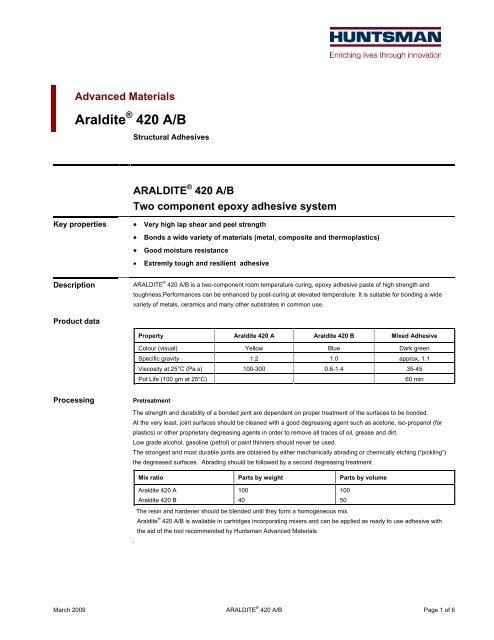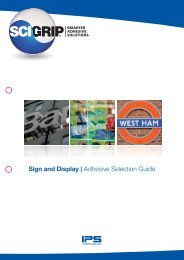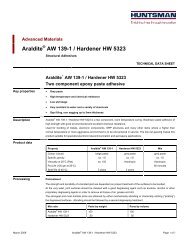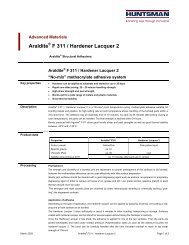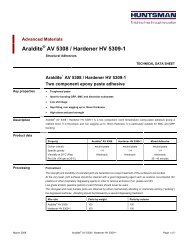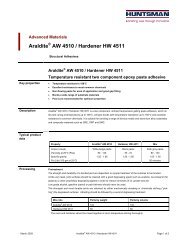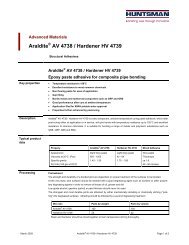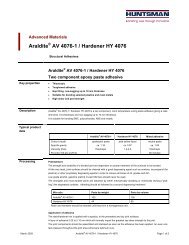Araldite 420 A/B - DanLube
Araldite 420 A/B - DanLube
Araldite 420 A/B - DanLube
- No tags were found...
You also want an ePaper? Increase the reach of your titles
YUMPU automatically turns print PDFs into web optimized ePapers that Google loves.
Advanced Materials<strong>Araldite</strong> ® <strong>420</strong> A/BStructural AdhesivesARALDITE ® <strong>420</strong> A/BTwo component epoxy adhesive systemKey propertiesVery high lap shear and peel strengthBonds a wide variety of materials (metal, composite and thermoplastics)Good moisture resistanceExtremly tough and resilient adhesiveDescriptionARALDITE ® <strong>420</strong> A/B is a two-component room temperature curing, epoxy adhesive paste of high strength andtoughness.Performances can be enhanced by post-curing at elevated temperature. It is suitable for bonding a widevariety of metals, ceramics and many other substrates in common use.Product dataProperty <strong>Araldite</strong> <strong>420</strong> A <strong>Araldite</strong> <strong>420</strong> B Mixed AdhesiveColour (visual) Yellow Blue Dark greenSpecific gravity 1.2 1.0 approx. 1.1Viscosity at 25°C (Pa.s) 100-300 0.6-1.4 35-45Pot Life (100 gm at 25 C)60 minProcessingPretreatmentThe strength and durability of a bonded joint are dependent on proper treatment of the surfaces to be bonded.At the very least, joint surfaces should be cleaned with a good degreasing agent such as acetone, iso-propanol (forplastics) or other proprietary degreasing agents in order to remove all traces of oil, grease and dirt.Low grade alcohol, gasoline (petrol) or paint thinners should never be used.The strongest and most durable joints are obtained by either mechanically abrading or chemically etching ( pickling )the degreased surfaces. Abrading should be followed by a second degreasing treatmentMix ratio Parts by weight Parts by volume<strong>Araldite</strong> <strong>420</strong> A 100 100<strong>Araldite</strong> <strong>420</strong> B 40 50The resin and hardener should be blended until they form a homogeneous mix.<strong>Araldite</strong> ® <strong>420</strong> A/B is available in cartridges incorporating mixers and can be applied as ready to use adhesive withthe aid of the tool recommended by Huntsman Advanced Materials.March 2009 ARALDITE ® <strong>420</strong> A/B Page 1 of 6
Application of adhesiveThe resin/hardener mix is applied with a spatula, to the pretreated and dry joint surfaces.A layer of adhesive 0.05 to 0.10 mm thick will normally impart the greatest lap shear strength to the joint.The joint components should be assembled and clamped as soon as the adhesive has been applied. An evencontact pressure throughout the joint area will ensure optimum cure.Mechanical processingSpecialist firms have developed metering, mixing and spreading equipment that enables the bulk processing ofadhesive.We will be pleased to advise customers on the choice of equipment for their particular needs.Equipment maintenanceAll tools should be cleaned with hot water and soap before adhesives residues have had time to cure. The removal ofcured residues is a difficult and time-consuming operation.If solvents such as acetone are used for cleaning, operatives should take the appropriate precautions and, in addition,avoid skin and eye contact.Times to minimum shear strengthTemperature C 23 40 60 100Cure time to reach hours 7.5LSS > 1N/mm 2 minutes 100 35 < 5Cure time to reach hours 11 2 1LSS > 10N/mm 2 minutes 20LSS = Lap shear strength.Typical curedpropertiesUnless otherwise stated, the figures given below were all determined by testing standard specimens made by lapjointing114 x 25 x 1.6 mm strips of aluminium alloy. The joint area was 12.5 x 25 mm in each case.The figures were determined with typical production batches using standard testing methods. They are provided solelyas technical information and do not constitute a product specification.Note: The data in this edition is based on recent retesting of the product.March 2009 ARALDITE ® <strong>420</strong> A/B Page 2 of 6
Average lap shear strengths of typical metal-to-metal joints (ISO 4587)Cured for 16 hours at 40°C and tested at 23 CPretreatment - Sand blastingAluminiumSteel 37/11Stainless steel V4AGalvanised steelCopperBrassN/mm 2 0 5 10 15 20 25 30N/mm 2Average lap shear strengths of typical plastic-to-plastic joints (ISO 4587)Cured for 16 hour at 40 C and tested at 23 C. Pretreatment - Lightly abrade and alcohol degrease.CFRPEP-GRPUP-GRPSMCABSPAPCPMMAPVCN/mm 20 5 10 15 20 25 30 35 40Lap shear strength versus temperature (ISO 4587) (typical average values)A: Cure: 4 hours at 50 C B: cure: 7 days at RT5040A30B2010°C0-55 0 22 40 60 80March 2009 ARALDITE ® <strong>420</strong> A/B Page 3 of 6
Glass transition temperatureCure: 16 hours at 40°C56 C by DMALap shear strength versus immersion in various media (typical average values)Unless otherwise stated, L.S.S. was determined after immersion for 30,60 and 90 days at 23 CCure: 16 hrs at 40°C30 days 60 days 90 daysN/mm 2 0 5 10 15 20 25 30 35 40As-made valueIMSFuel (unleaded)Ethyl acetateAcetic acid, 10%XyleneLubricating oilParaffinWater at 23°CWater at 60°CWater at 90°CTensile strength at 23 C (ISO 527)E-modulusElongation at breakShore Hardness (D scale) (ISO 868/03)Cure 16 hours/ 40ºC , tested at 23ºC,50%RHShear modulus G (ISO 6721)Cure: 16 hours/ 40 C-20 C - 1.00 GPa0 C - 880 MPa23 C - 730 MPa60 C - 74 MPa90 C - 5.5 MPa29 MPa1495 MPa4.6 %75 DMarch 2009 ARALDITE ® <strong>420</strong> A/B Page 4 of 6
StorageARALDITE ® <strong>420</strong>A and <strong>Araldite</strong> ® <strong>420</strong> B may be stored for up to 3 years at room temperature provided the componentsare stored in sealed containers. The expiry date is indicated on the label.HandlingprecautionsCautionOur products are generally quite harmless to handle provided that certain precautions normally taken when handlingchemicals are observed. The uncured materials must not, for instance, be allowed to come into contact withfoodstuffs or food utensils, and measures should be taken to prevent the uncured materials from coming in contactwith the skin, since people with particularly sensitive skin may be affected. The wearing of impervious rubber orplastic gloves will normally be necessary; likewise the use of eye protection. The skin should be thoroughly cleansedat the end of each working period by washing with soap and warm water. The use of solvents is to be avoided.Disposable paper - not cloth towels - should be used to dry the skin. Adequate ventilation of the working area isrecommended. These precautions are described in greater detail in the Material Safety Data sheets for the individualproducts and should be referred to for fuller information.HuntsmanAdvancedMaterialsAll recommendations for the use of our products, whether given by us in writing, verbally, or to be implied from theresults of tests carried out by us, are based on the current state of our knowledge. Notwithstanding any suchrecommendations the Buyer shall remain responsible for satisfying himself that the products as supplied by us aresuitable for his intended process or purpose. Since we cannot control the application, use or processing of theproducts, we cannot accept responsibility therefor. The Buyer shall ensure that the intended use of the products willnot infringe any third party s intellectual property rights. We warrant that our products are free from defects inaccordance with and subject to our general conditions of supply.Huntsman Advanced Materials warrants only that its products meet the specifications agreed with the buyer. Typical properties,where stated, are to be considered as representative of current production and should not be treated as specifications.The manufacture of materials is the subject of granted patents and patent applications; freedom to operate patented processes isnot implied by this publication.While all the information and recommendations in this publication are, to the best of our knowledge, information and belief,accurate at the date of publication, NOTHING HEREIN IS TO BE CONSTRUED AS A WARRANTY, EXPRESS OROTHERWISE.IN ALL CASES, IT IS THE RESPONSIBILITY OF THE USER TO DETERMINE THE APPLICABILITY OF SUCH INFORMATIONAND RECOMMENDATIONS AND THE SUITABILITY OF ANY PRODUCT FOR ITS OWN PARTICULAR PURPOSE.Huntsman Advanced Materials(Switzerland) GmbHKlybeckstrasse 2004057 BaselSwitzerlandTel: +41 (0)61 299 11 11Fax: +41 (0)61 299 11 12www.huntsman.com/advanced_materialsEmail: advanced_materials@huntsman.comThe behaviour of the products referred to in this publication in manufacturing processes and their suitability in any given end-useenvironment are dependent upon various conditions such as chemical compatibility, temperature, and other variables, which arenot known to Huntsman Advanced Materials. It is the responsibility of the user to evaluate the manufacturing circumstances andthe final product under actual end-use requirements and to adequately advise and warn purchasers and users thereof.Products may be toxic and require special precautions in handling. The user should obtain Safety Data Sheets from HuntsmanAdvanced Materials containing detailed information on toxicity, together with proper shipping, handling and storage procedures,and should comply with all applicable safety and environmental standards.Hazards, toxicity and behaviour of the products may differ when used with other materials and are dependent on manufacturingcircumstances or other processes. Such hazards, toxicity and behaviour should be determined by the user and made known tohandlers, processors and end users.Except where explicitly agreed otherwise, the sale of products referred to in this publication is subject to the general terms andconditions of sale of Huntsman Advanced Materials LLC or of its affiliated companies including without limitation, HuntsmanAdvanced Materials (Europe) BVBA, Huntsman Advanced Materials Americas Inc., and Huntsman Advanced Materials (HongKong) Ltd.Huntsman Advanced Materials is an international business unit of Huntsman Corporation. Huntsman Advanced Materials tradesthrough Huntsman affiliated companies in different countries including but not limited to Huntsman Advanced Materials LLC in theUSA and Huntsman Advanced Materials (Europe) BVBA in Europe.<strong>Araldite</strong> is a registered trademark of Huntsman Corporation or an affiliate thereof.Copyright © 2008 Huntsman Corporation or an affiliate thereof. All rights reserved.March 2009 ARALDITE ® <strong>420</strong> A/B Page 5 of 6


